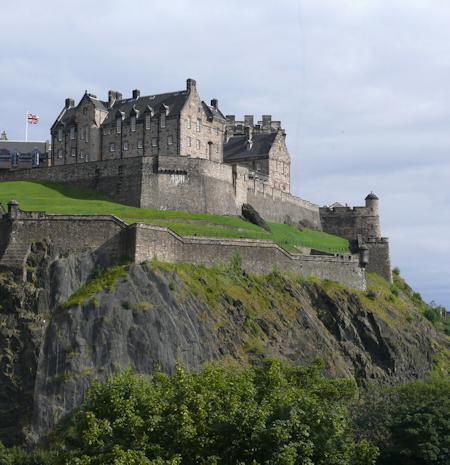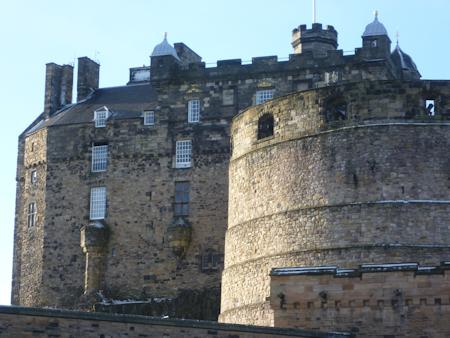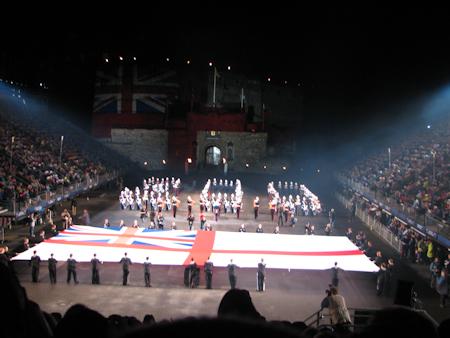
Edinburgh Castle
The history of the castle at Edinburgh is entwined with the history of Scotland itself. Edinburgh Castle stands proudly on a rocky volcanic outcrop above the City of Edinburgh. Its strategic importance is self-evident as it dominates the fertile lands of Lothian and the Firth of Forth. The castle gates are at the end of the Royal Mile in the west end of Edinburgh. On its north and south flanks lie sheer cliffs and the west sees would-be attackers facing a steep and dangerous ascent.
The exact nature of the early fortresses here is unclear. The site of the castle has been occupied since pre-history. The earliest written reference to the fortress here comes in 600AD from the epic poem Gododdin which tells of warriors who went from the castle to do battle with the Angles of Northumbria. The Gododdin were massacred and the Kingdom of Northumbria took control of the area for several centuries and gave it its name – Edinburgh.
The First Castle at Edinburgh
It was Malcolm II who took Edinburgh Rock for the Scots in 1018 with victory at the Battle of Carham. Malcolm III built a wooden castle here, but it was during the reign of David I that the castle rose to prominence. David I held the first pre-cursor to the Scottish Parliament here in 1140. He also built the first stone buildings at Edinburgh Castle including the tiny St Margaret's chapel, named for his mother, which is the oldest surviving building in the castle precincts.
Many of the buildings were rebuilt in stone during the 13th Century and the castle became an important site of Scottish royal power.
In 1296 Edward I of England invaded Scotland and made straight for Edinburgh Castle. He captured it and installed an unusually large garrison of over 300 knights. He also brought up his master craftsmen from Wales to work on the castle defences.
Edward I held on to the castle until the spring of 1314. Thomas Randolph, 1st Earl of Moray, recaptured the castle with 30 hand-picked men by scaling the treacherous north face and taking the garrison by surprise. Robert the Bruce then slighted the castle so that the English couldn't re-occupy it.
Slighted and Rebuilt
The Scots held the castle until 1335 when Edward III of England retook the castle and refortified it. He kept it until 1341 when William Douglas, Lord of Liddlesdale assaulted it again. Sir William disguised his men as merchants and used wagons to block the castle gates before the defenders realised they were under attack.
Robert the Bruce's son, David II, rebuilt the fortress and added an impressive tower in 1361. David's Tower was destroyed in the 16th Century, but those who saw it before then rated it as one of the most impregnable in Christdom. The tower stood on the site of the present Half Moon Battery and connected via curtains walls to a tower where the Portcullis Gate now stands.
During the 15th Century the Edinburgh Castle was increasingly used as an arsenal and armaments factory. In 1457 the massive Belgian cannon Mons Meg was delivered. Mons Meg is still on display today, unfortunately she isn't in working condition since her barrel burst in 1681.
A Foundry and Royal Palace
Edinburgh became the principal foundry in Scotland and Scottish European bronze smiths produced a variety of cannon for Scottish and European ships. There were also Dutch smiths in the town producing early forms of firearms.
In 1505 James VI constructed Hollyrood Palace at the opposite end of the Royal Mile from the castle as his main residence and from then on the castle gradually fell out of favour as a royal home.
Mary, Queen of Scots took the Scottish throne in 1542. Her reign was troubled because she was a Catholic queen and most of the Scottish nobility were Protestant. Her forced abdication at Loch Leven Castle in 1567 left the country in a state of civil war. Edinburgh Castle was untroubled by many of the early skirmishes, but in 1571-73 the castle was besieged. The "Lang Siege" (Long Siege) saw Queen Mary's supporters occupying the castle with supporters of Mary's son, the infant King James VI, outside. The siege was ended by English troops in May 1573. They extensively bombarded the castle, destroying David's Tower, Constable's Tower and captured the outer fortifications.
Much of the castle was subsequently rebuilt. The outer fortifications were repaired and the Half Moon Battery and Portcullis Gate were constructed. The Battery is still a prominent feature on the east side of the castle. It was built around and over David's Tower. Parts of David's Tower still survive and some rooms are accessible to the public.
Edinburgh Castle became less important as a royal residence and the last reigning monarch to stay there was King Charles I in 1633. He held a feast there before his coronation as King of Scots and stayed only one night.
The castle suffered a further three month siege and more damage when Oliver Cromwell's forces took the castle in 1650.
A Garrison and Prison
In 1660 Charles II decided to keep a full time garrison maintained at the castle. It served as a garrison until 1923 when the last of the soldiers moved out to Redford Barracks in south-west Edinburgh. The castle was almost taken during the Jacobite rebellions, but it managed to hold out during both.
The castle was extensively refortified during the 1720s and 30s with a number of new artillery defences and bastions being built. The Argyle Battery, Mills Mount Battery and the Western Defences were all constructed during this time.
The castle was used as a prison for prisoners of war from about the mid 18th Century until 1814 and again during the First World War.
There were various excavations during the 19th Century. In 1818 Sir Walter Scott discovered the Honours of Scotland walled up in a room and St Margaret's Chapel was rediscovered in 1845. In the 1880s the Argyle Tower was constructed over the Portcullis Gate and the Great Hall was restored after being used as a barracks.
Tourist Attraction
The 1830s saw the castle opened to the public. The Honours of Scotland were put on public display and Mons Meg was brought back from London.
In 1991 ownership of the castle passed to Historic Scotland. Edinburgh Castle is the most popular paid visitor attraction in Scotland. There are a number of shops and cafes within the castle precincts and many of the castle's building and rooms are open to the public with numerous historical displays.
The castle maintains its strong relationship with the British Army and it is one of very few ancient castles that still have a garrison. Each year the castle plays host to the Edinburgh Military Tattoo – a parade of the pipes and drums of the Scottish regiments which is broadcast around the world.
Attractions at the castle include Mons Meg (the massive cannon) and some of her shot; the National War Museum of Scotland which covers 400 years of Scottish military history; the Royal Palace which also houses the Crown Room which contains the Honours of Scotland and the crown, sceptre and sword of state and the Stone of Scone.
Edinburgh Castle is a recognisable symbol of both Edinburgh and Scotland. Its image is used on coats of arms and on logos and it has appeared on stamps and banknotes.
Status: Museum / Event Venue / Wedding Venue
Owner: Heritage Scotland
Tel: +44 (0)131 225 9846
Email: hs.ticketing@scotland.gsi.gov.uk
Website: www.edinburghcastle.gov.uk
Opening Times: Summer 9:30am to 6pm / Winter 9:30am to 5pm


Edinburgh Castle viewed from Princes Street

Half Moon Battery and Palace Block

Edinburgh Military Tattoo